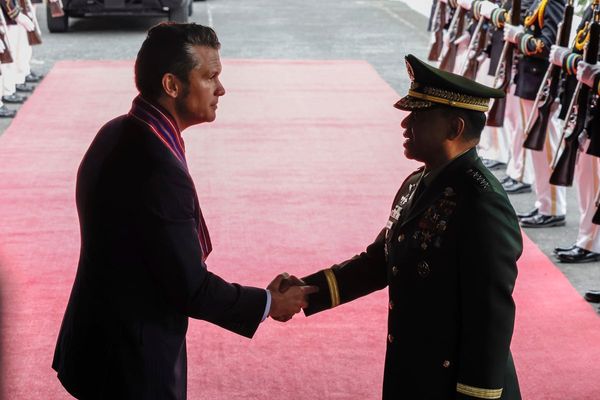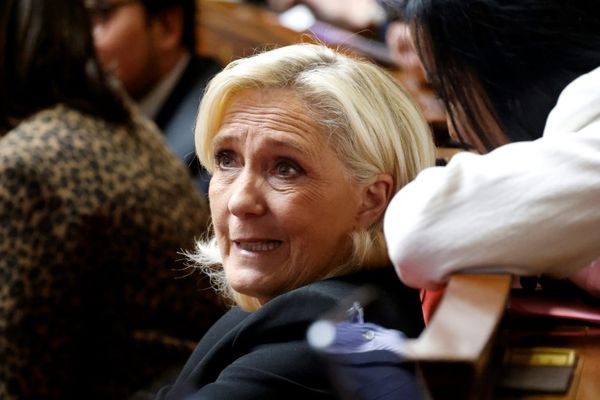
Donald Trump’s dramatic arrest and arraignment in New York City on Tuesday posed a conundrum for the media.
Should they follow the case closely, knowing how Trump-drama boosted viewership, readership, and revenue during his presidency? Or cut off the free airtime and exposure Trump craves, and limit the potential for the former president to twist the arrest to his own benefit?
The scenes in New York answered that question.
The main American news networks handed over their coverage to the Trump-arrest story and several paid for helicopters to follow the Trump motorcade as he left Trump Tower, headed south towards the Manhattan criminal court.
At the court itself, the number of journalists dwarfed the number of people at pro- and anti-Trump rallies. From a distance the road outside the court looked like a street market, with dozens of gazebo tents erected in advance to house scores of cameras and producers.
There were photographers huddled in a corner, wobbling on step ladders and weighed down by huge telephoto lenses. The noise of the helicopters echoed off the tall lower Manhattan buildings and was picked up by an array of boom mics.
“The first-ever arraignment of a former president on criminal charges is a massive story, no question about it,” Adam Serwer wrote in the Atlantic.

“But by itself that doesn’t really explain the minute-by-minute broadcasting of his private plane arriving in New York Monday or the blanket coverage of his speech yesterday evening. That kind of saturation approach suggests the networks could return to a model that simply allowed Trump to monopolize coverage.”
The impact of the media’s coverage of Trump in the 2016 presidential election has been well documented.
“They let Trump, the great distractor, hijack news coverage and play assignment editor. He became the shiny new toy that they couldn’t take their eyes off,” Margaret Sullivan, the media commentator now a Guardian columnist, wrote in 2020.
Trump enjoyed a disproportionate amount of media coverage in the Republican primaries and in the election that year. He was a guarantee of increased viewers and page-clicks, while many organizations were accused of not being critical enough in their coverage, and criticized for underestimating his chances of winning.
The memory of that coverage was not lost on the non-journalists outside the court.
“[This] has never happened before, I understand that historically,” said Tony Lopez, a non-Trump voter who was there to witness the spectacle.
“But it has to be covered properly. The only ones who came out to support him is the media. They covered him leaving Florida, landing, every step and this is going to fuel his supporters even more.”

If anything, Lopez’s statement underplayed the free coverage Trump received during the 2016 election.
The New York Times reported that through February 2016, when the Republican primaries were under way, Trump had earned “close to $2bn worth of media attention” across print, broadcast, online news outlets and social media. Bearing in mind that the actual election only took place in November 2016, that’s a lot of free publicity.
“Watching cable TV’s nonstop, post-arraignment helicopter coverage of Trump’s 11-car motorcade heading up the FDR Drive to LaGuardia airport served as a reminder that the media – like the Bourbon monarchy – have learned nothing and forgotten nothing,” Walter Shapiro, a lecturer in political science at Yale, wrote in the Guardian. “With the slightest excuse, they revert to their 2016 all-Trump-all-the-time playbook.”
Moreover, of the coverage of early 2016 presidential candidates, Trump received 63% of the coverage, the Harvard Kennedy School found in a 2016 report, and during the general election he received 15% more coverage than Hillary Clinton.
The coverage of some also distracted from what proved a more consequential political story: Janet Protasiewicz, a liberal judge, defeated Dan Kelly, a far-right justice, for a seat on Wisconsin’s supreme court.
If the daytime coverage had been exhaustive – “and exhausting”, as Poynter put it – at least most people calmed down, a little, by night, suggesting some lessons may have been learned.
In the 2016 election Trump’s speeches were frequently covered live, without commentary or correction, by news programs and channels.
At least Trump’s grievance-laden, lie-filled speech on Tuesday evening, once he had returned to the private member’s club where he now lives, was covered less extensively, in a sign that perhaps there has been some lessons learned in recent years.
The major networks – ABC, CBS, NBC – did not cover the speech live. CNN aired most of it, followed by a largely critical commentary, while Fox News, as might be expected, handed over all its airtime to the irate former president.
MSNBC went to lengths to avoid the speech, and Rachel Maddow, host of an eponymous show on the channel, explained the decision on air.
“There’s a cost to us as a news organization of knowingly broadcasting untrue things,” Maddow told viewers. News organizations like NPR, and the Guardian, similarly chose to avoid livestreaming the entire Trump speech, and to fact-check it in real time.
“So, our deal with you is that we will monitor these remarks. If he does say anything newsworthy, we will turn them around and report on that right away. But for now, just know that it’s happening and we’re not taking it.”
With the trial only scheduled for 2024, and a series of other indictments of Trump possible in the coming months, it remains to be seen how the media continues to deal with Trump.
On Tuesday, at least, the future did not look particularly bright.







